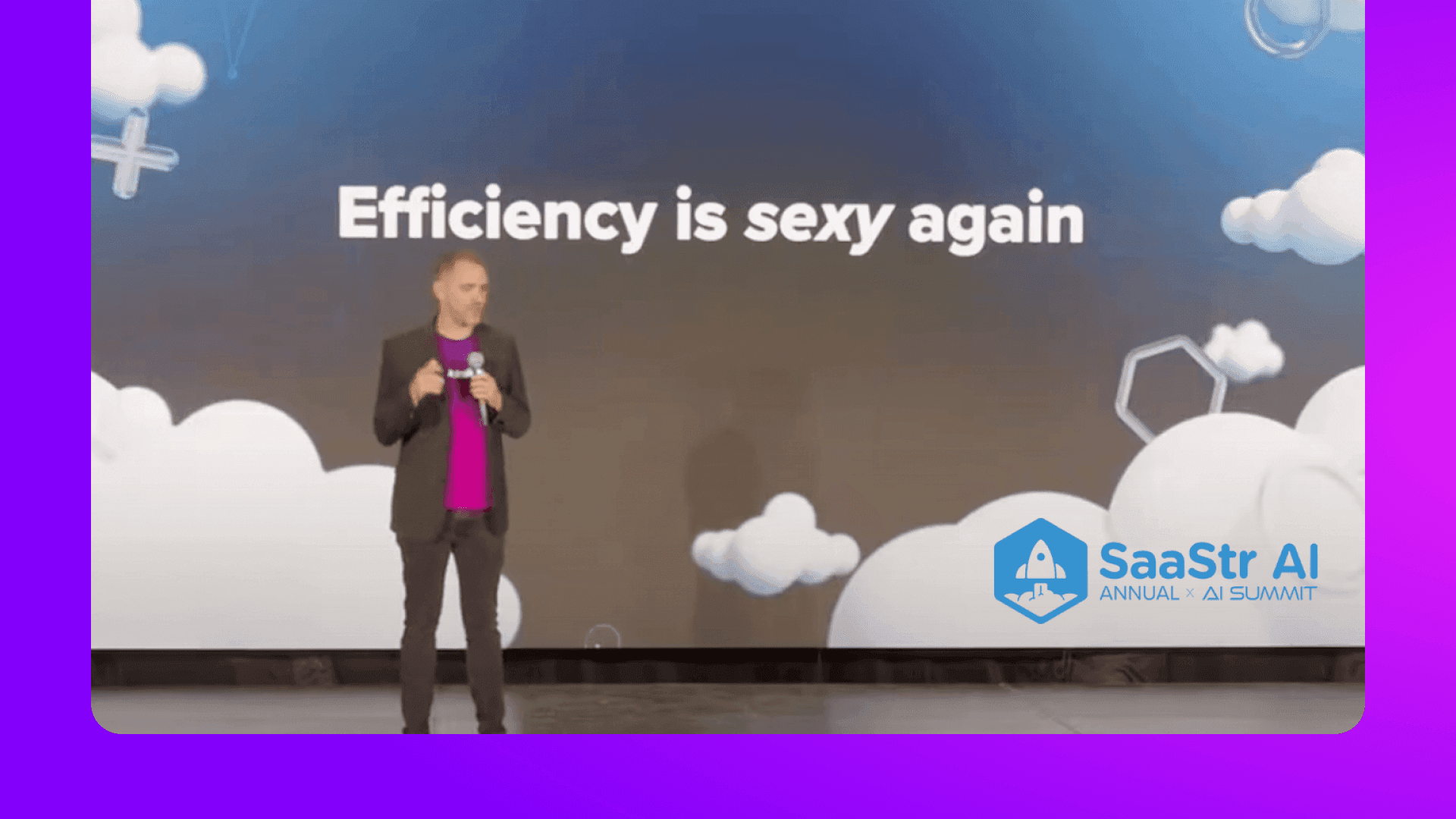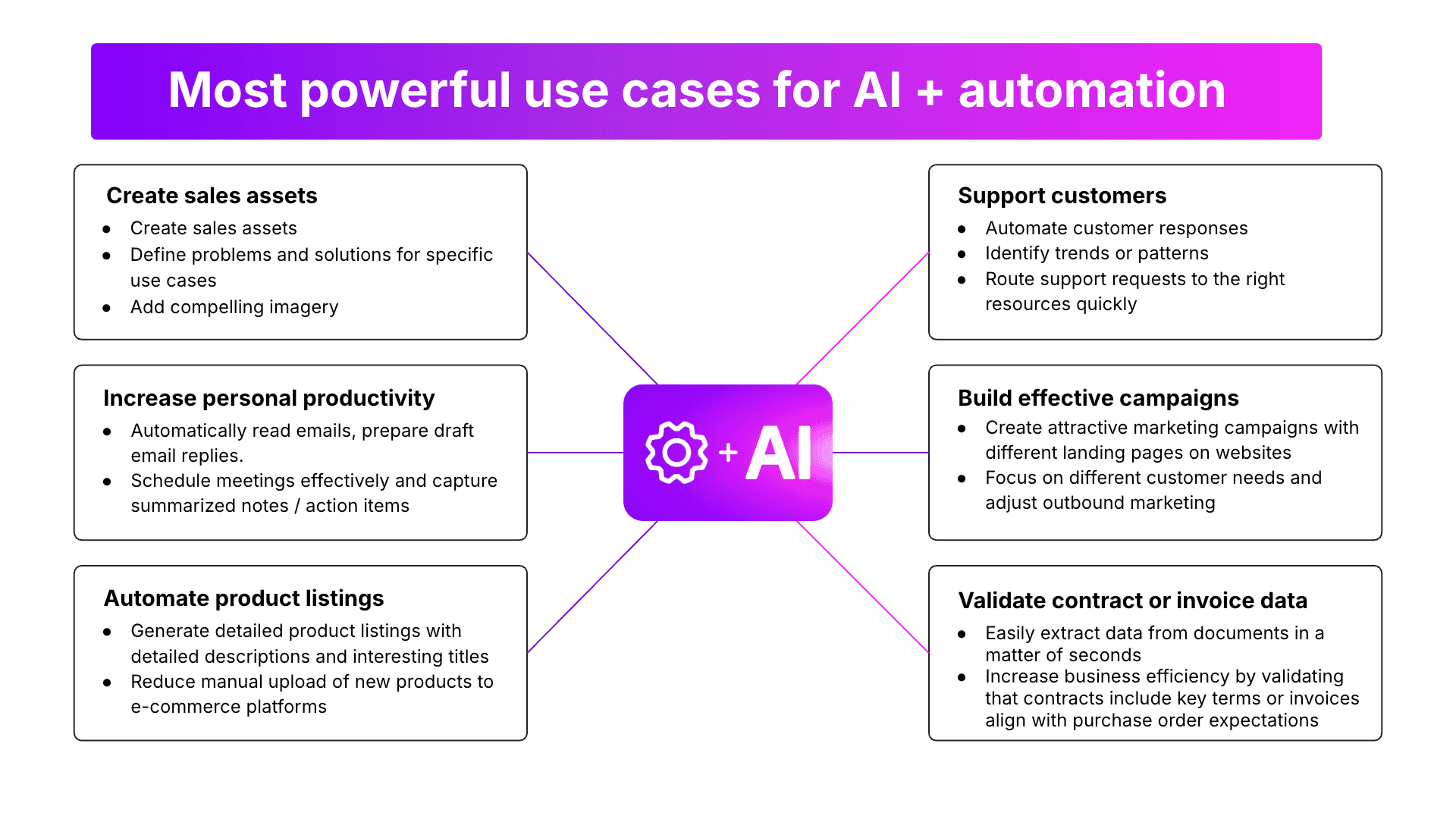May 27, 2025 | 5 minutes
How to build the world's smallest $100M ARR business
Darin Patterson, VP of Market Strategy at Make, outlines the unique approach to growth that today's highest-performing companies share, plus the AI-powered methods and tools that help them deliver.

A couple weeks ago, Make made a splash at SaaStr Annual 2025. In addition to helping our team spread the word about Make's latest AI and no-code rollouts, I had the pleasure to deliver a presentation to over 10,000 cloud, SaaS, and AI founders, VCs, and execs, each of them keen to build their business from $0 to $100M annual recurring revenue (ARR). This isn't new to me: over the last 15 years I've helped companies large and small bring together engaged employees in effective processes to stay competitive.
As I started prepping my talk, it occurred to me that today's highest-performing companies all share a very specific approach to growth: a focus on efficient growth. Higher ARR with lower headcount. In today's unpredictable business climate, companies that know how to grow this way have never seemed sexier to investors, and for the businesses themselves, it may actually be easier to grow with fewer people. Watch or read below for my breakdown of what growing efficiently means and the resources – both human and technical – that make that possible.
What we mean when we talk about efficient growth
Think about the typical approach to expanding a business: you hire more people. But when you hire more people, how many more calories are spent introducing new management layers, implementing decisioning processes, propagating messages, and holding meetings (and more meetings)? All of that energy could – should – be focused on learning more about your customers and innovating your product instead.
Growing efficiently, then, can be summed up by a simple metric that often gets unfairly overlooked in favor of flashier SaaS numbers: ARR per employee. How big you can get without having to add more humans into the mix.
Lovable is a perfect example. This Swedish AI coding startup isn't a 100M ARR business yet – but it's one of the fastest-growing startups in history and it’ll be there in no time. It grew from $0 to $10M ARR in only 60 days. Then $17M ARR and 30,000 customers in 90 days. And now? $30M ARR in 120 days, while burning just $2M. Here's the kicker: they did it all with 18 people.
This translates to more than $1M ARR per employee. Now there's growth that's all about efficiency.
Engaging with and researching Lovable and companies like it, I can tell you – they all share three features that enable them to grow like this: cultures, key technologies, and business practices.
Culture
It all starts with the basics: culture. It's one of those things that can seriously hurt you later on if not done right and right at the beginning.
Culture first takes shape among the people you surround yourself with, and it's the way your team thinks and acts together to get things done. So it’s incredibly important to be very selective about who you hire from the very earliest stages.
The co-founder of Lovable emphasizes that they hire super high-agency people and very technically focused talent. This means fewer management layers and that even senior hires are player-coaches that can actually do their share of IC work.
Want more thoughts from Darin?
Darin's psychology background and tech experience make him a leading voice shaping the future of work. Read all of his in-depth writing about AI and agentic automation.
Second, these companies embrace experimentation as a core cultural element. They're never satisfied with the status quo, and their employees are fully empowered to try out new ideas – to continually tweak and refine, to question the things that have always been that way.
It's extremely important to emphasize that if you're genuinely serious about a culture of experimentation and innovation, that means you're serious about embracing failure too. Failure increases learning – and learning faster than anyone else is a game-changer. Guy Podjarny, founder of Snyk, reminds us that we all “probably overestimate how much the people in the past have succeeded and how much those people really knew what they were doing”. In reality, failure is a core part of achieving notable success.
AI and automation
But just building a culture of experimentation, innovation, and useful failures can't stand alone – small teams more than anyone need the technology that will let them embody that culture in a product or service. It's 2025, so you can probably guess the tech I'm alluding to.
Yes, these companies radically champion the use of artificial intelligence both internally and externally. But you actually can’t deploy AI effectively without automation. Simply put, your employees will be most empowered only if you give them accessible ways to apply AI to their existing and evolving business processes, whatever those processes may be. The way to do that is through democratized automation – mostly this is just another way of saying no-code.
No-code automation tools support experimenting culture because oftentimes businesses don’t actually know which use cases are going to produce the most value when AI is applied to them. But even without knowing exactly where AI will offer the best bang for your buck, you can still think about the things that AI is really good at, how you can map those onto your core processes, and how you can then tweak things for the best outcomes. For just a few examples:
Sentiment analysis: AI can eliminate the need for customer support headcount while providing more accurate and satisfying services.
Data classification: AI automation can identify freeform data and keep you more compliant, faster.
Data transformation: No-code tools can bridge gaps in languages and formats to enable you to work with international systems seamlessly.
Data extraction: No-code plus AI can eliminate data input bottlenecks to keep information and cash flowing.
Growth mindset
Culture and technology are the foundations that the world's best companies lay, and key business practices naturally emerge from these.
The first of these practices is that employees routinely demonstrate growth mindsets. They have a core belief that their talents and smarts aren’t fixed – they know that they don’t know everything, and they're constantly embracing new things, new technologies, and new skills from continuous feedback.
The second major practice adopted by these super-efficient companies is actually very difficult for the perfectionists among us: STOP building future-proof solutions. Stop trying to cover every edge case and meet every specification – it's just not possible. Even if it was, the effort is a major drag on growth.
This concept applies to your product, but also your internal processes. Instead, in everything you do, ask yourself, "What is the bare minimum necessary to prove this concept works? What is the smallest value I can deliver incrementally?" Test your ideas, learn more, iterate. Then – and only then – think about scaling. This allows for flexibility, faster iterations, and ultimately, more growth – efficient, sustainable, growth.
Efficiency is sexy again
Whoever the world’s smallest $100 million ARR company turns out to be, it's undoubtedly going to be a model of efficient growth. It's going to be selective about who joins the team. It's going to embed AI and democratized automation throughout its processes. It's going to embrace a humble growth mindset and worry about scaling only when the time is right. And, I think, it's going to be built with Make.







